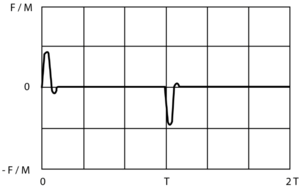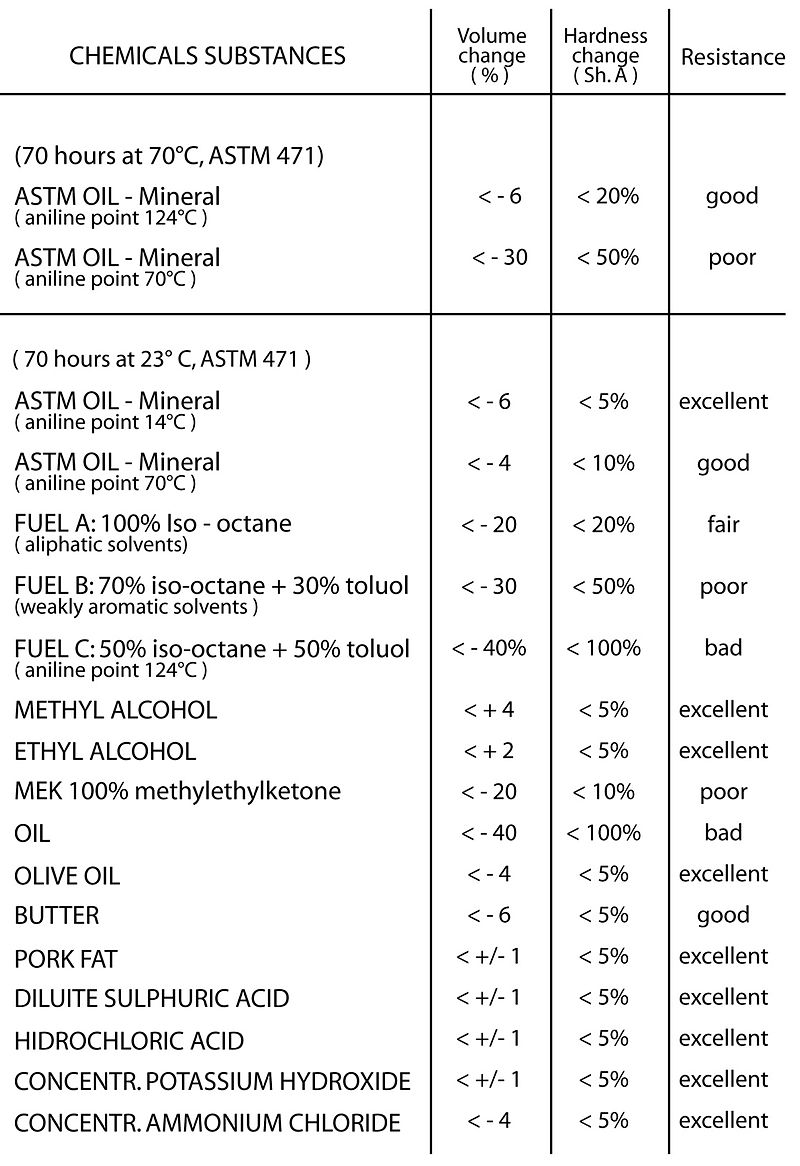SCOP formalism
AN-VI is a member of the rubber family, with characteristics different from those of traditional elastomers. It has the elasticity of a good rubber but it also has unusual damping capacities: by deformation it absorbs energy from an elastic material and as a damper it dissipates the energy absorbed. One part of the energy is converted into heat while the other part is returned so slowly as to have practically no dynamic effects. In solid form AN-VI can be used to reduce shock and impact stress effects as a vibration damper.Foamed, it finds use with not too heavy loads.
AN-VI is the industrial evolution of a product, Noene, used for years in the medical field, where the material has also shown a very low tendency to aging.


Mechanical features
Shock absorption

The image shows the reduction of shock effects and the attenuation of impact vibrations generated by repeated blows of metal on metal. The graphs illustrate the force transmitted by a free-falling steel ball on a load cell. Between the ball and the instrument there are three test pieces consisting alternatively of natural rubber, ethyl-vinylacetate (EVA) and AN-VI. The test was performed under equal conditions (highness of the fall and size of the pieces): AN-VI absorbs the shock energy completely (there is no second or rebound shock) and this reduces the transmitted force.
Rebound elasticity

One of the major characteristics which sets AN-VI apart from other good quality elastomers is its rebound elasticity. This quantity is a parameter expressing the capacity of the material to dissipate mechanical energy. It is measured by means of an instrument called the Rebound Pendulum which measures how much mechanical energy is put back into a steel ball falling from a specific height on to a test piece of the material under examination. With AN-VI, for temperature between 0° and 30°, less than 5% of the ball’s prefall potential energy is put back into the ball. The remaining 95% is dissipated by the AN-VI.
On the picture on the right the AN-VI’s rebound elasticity is illustrated in comparison with that of other common elastomers, as a function of temperature. In a range of temperature from -20° to +60°C, which includes most normal applications, the rebound elasticity of An-VI is lower than that of all other elastomers.

The picture on the left shows the behavior of AN-VI according to the frequency of vibration, compared with other different elastomers.
The chart was defined in 2010 from the Politecnico di Torino - Interdisciplinary Mechatronics Laboratory during an experiment carried out using AN-VI to stabilize electrodynamics rotor-bearings.
Damping properties
AN-VI’s capacity in damping impulse and transitory vibrations as well as stationary and pseudostationary dynamic actions is apparent in its hysteresis behaviour.
Referring to the symbol table and to the oscillator model below,

| Parameter | Symbol | Unit |
|---|---|---|
|
Time Frequency Pulsation Displacement Speed Acceleration Force Mass Elastic stiffness Viscous damping Hysteresis stiffness Imaginary unit Viscous damping factor Hysteresis damping factor Natural pulsation Natural frequency Natural period Natural damping factor |
t f w = 6,28 f s(t) v(t) = ds(t) / dt a(t) = dv (t) / dt F (t) M K B C i nv = B / (2 Sqr (K/M)) ni= C/2K wo= Sqr (K/M) fo= (1/6,28) Sqr (K/M) To= 1/fo no=nv + ni |
S Hz rad/s m m/s (m/s)/s N Kg N/m N /(m/s) N/m i ad ad rad/s Hz s ad |
Take test pieces of materials and subject them to a squash s (t) of unit amplitude (1 cm),changing according to harmonic law (with pulsation w). Then:
Graph the relationship between the squash (s) and the force (F) required to produce the desired displacement
The behaviour shown in the first figure refers to a perfectly elastic material, such as steel.
The relation between (s) and (F) is a straight line whose slope (K) represents the elastic stiffness of the sample.
The elastic energy (Ee) required to cover the load-phase (half circle)
Is given back in total in the upload phase.
The behaviour of the elastomers, shown in the other figures on next page, diverges from that of the steel in that the straight lines of steel becomes an s/F closed curve and represents the hysteresis circle of the material.
The area enclosed by the curve is a measure of the hysteresis Energy (E) expended in one circle of the system.
The ratio (Ri) between hysteresis energy (Ei) and the energy associated with the elastic half-cycle (Ee) is an index of the material’s hysteretic dissipative capacities:
The hysteresis properties of materials are expressed in terms of hysteretic stiffness , or hysteretic damping coefficient, which has the same dimensions as elastic stiffness , and therefore the total force to be applied to the sample to produce the cycle is given by:
The ratio (2 nl) between the two stiffnesses represents the loss factor or hysteresis damping factor or hysteresis damping factor.
The parameter:
is connected to the Energy ratio by the formula:
The greater the hysteresis capacity for dissipating mechanical Energy, the fatter is the cycle shape. With the test, the difference between the behaviours of AN-VI and other elastomers can be quantified. Given that all good quality rubbers have respectable hysteresis damping factor (ni), AN-VI’s particularly high.

| Parameter | Rubber | AN-VI |
|---|---|---|
| Rebound elasticity at 20°C
Loss factor 2ni = C / K Hysteresis factor ni = C / (2K) Energy ratio Ri = Ei / Ee |
Dal 20% al 40%
From 10% to 30% From 5% to 15% From 16% to 47% |
From 2% to 5%
From 120% to 80% From 60% to 90% From 188% to 283% |
Transitory phenomena
Transitory phenomena have their origin in events which last only for a very short time. An example is the rectangular impulse illustrated below in the figure, resulting from the application of a load (F), which remains constant for a period of time (T). In fact the response of the mechanical system is usually characterized by complex oscillatory phenomena during the loading phase, in passing from (0) to (F).
The higher the natural damping factor (no) of the system, the quicker the phenomenon disappears. The diagrams give evidence of the differences in behaviour between an ordinary rubber (no = 30%) and AN-VI (no = 60%). The extent of displacement depends upon the stiffness (K) of the system. The response oscillation amplitude a (t) is inversely proportional to the mass (M). The diagrams confirm that significant effects are obtained through the use of AN-VI insofar as the transitory phenomena caused by the system’s free oscillations are concerned, both in the loading phase and in the unloading phase.
The shorter oscillation damping time also reduces the risk of dangerous synchronizations due to the superimposing of return waves on the outgoing waves.
The pictures show the transitory for the different materials.
Transitory phenomena
Transitory phenomena have their origin in events which last only for a very short time.
A theoretical example, schematically very simple, is the rectangular impulse illustrated below in the figure, resulting from the application of a load ( F ), which remains constant for a period of time ( T ). In fact the response of the mechanical system is usually characterized by complex oscillatory phenomena during the loading phase, in passing from ( 0 ) to ( F ).
Higher is the natural damping factor ( no ) of the system quicker is the phenomena disappearing.
The diagrams give evidence of the differences in behaviour between an ordinary rubber ( no = 30% ) and AN-VI ( no = 60% ).
The extent of displacement depends upon the stiffness ( K ) of the system.
Response oscillation amplitude a ( t ) is inversely proportional to the mass ( M ). The diagrams confirm that significant effects are obtained through the use of AN-VI insofar as the transitory phenomena caused by the system’s free oscillations are concerned, both in the loading phase and in the unloading phase.
The shorter oscillation damping time also reduces the risk of dangerous synchronizations due to the superimposing of return waves on the outgoing waves.
The pictures show the transitory for the different materials.
- RUBBER (on the left) Vs. AN-VI (on the right) - Politecnico di Milano
Mechanical features table
Chemical features table
Electrical features
AN-VI is classified, from an electrical point of view as an insulating material.
Anyway, even if it cannot be classified as material with ESD protection, the quantity of the charge generated by triboelectric effect is limited: undergoing to a rubbing process, AN-VI features an accumulation inferior to 500V, while normal insulating plastics gets tens of thousands Volt.
According to the above features, the material results to be particularly suitable to be used in electrical and electronics field in direct contact with circuitry without any particular risk of conduction or electrostatic discharges.
Use
Industry
Vibration deadening in rotatory and reciprocating machines, linings for hoppers and containers suffering shock from falling materials, vibratory separators, metal panel deadening, handgrip covers, portable machine tool uncouplers
Automotive, Rail, Aereospace, Naval e Yachts
Lining and covers, rebound bumpers, racing car interiors
Railwais superstructure
Rail chairs, superstructure platform supports, signlling and shunting box connections
Building
Slab supports, bearings, joints, floating floors
Electronics and precision instrumentation
Coverings, equipment supports and fixings
Hi-Fi
Coverings, supports and fixings for soundboxes and record-players
Hydraulics’
Piping anchorage, pump uncouplers, joint seals
Office machines
Supports and base plates for printers and computers
Aeronautics
Helicopter landing platforms
See also
References
- http://asmedl.org/journals/doc/ASMEDL-home/asmedlLogin.jsp?purchasable=true&d=1349184354410 Politecnico di Torino, IT - Mechatronics Laboratory - N. Amati, A Tonoli, F. Impinna, J.G. Detoni - AN-VI The solution for Electrodynamic Bearing Stability - 2011, April,
- Politecnico di Torino, IT - Mechatronics Laboratory - Center for Prototyping Services - F. Impinna - Identificazione Loss factor e Modulo elastico del materiale AN-VI - 2011, February
- Politecnico di Milano, IT - Centro di Bioingegneria - Servizio Ricerche Biomeccaniche - Caratterizzazione NOENE - 1988






